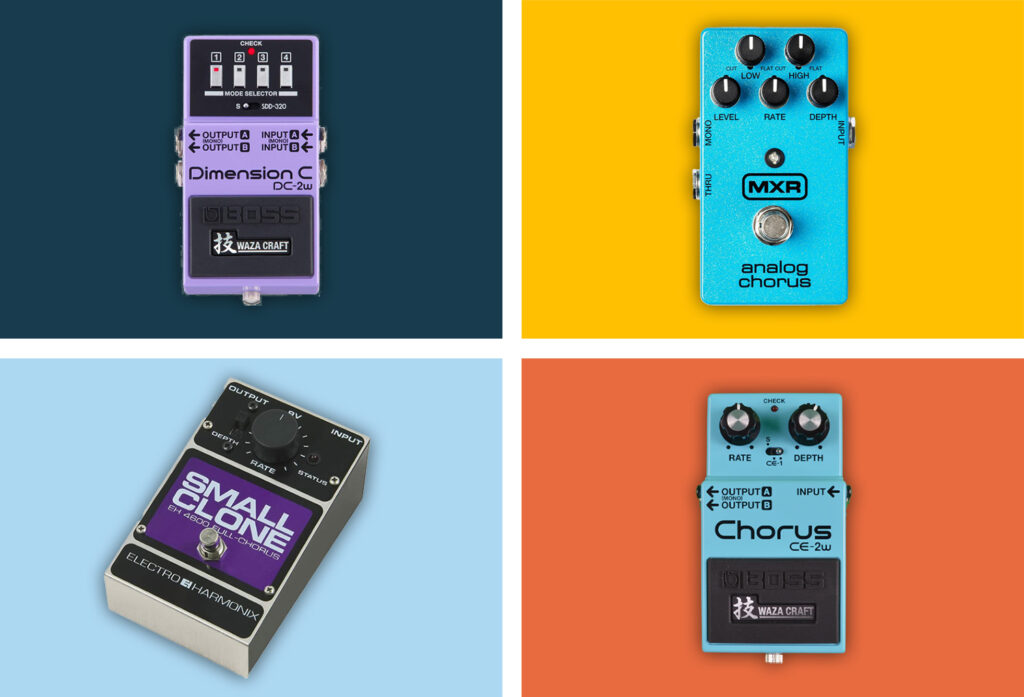The origins of the chorus effect can be traced back to attempts to reproduce or amplify the sound of stringed instruments. Early versions of the effect were achieved by simultaneously playing identical audio signals with slightly different delays and/or pitches. In other words, like a delay with extremely short delay times. This created a kind of double effect, giving the impression that several instruments were playing at the same time.
The actual invention of the chorus pedal as we know it today came with the advent of compact electronic circuits based on semiconductors. The first application of a chorus effect was the Roland Jazz Chorus guitar amp in 1975, which was the first to feature a built-in chorus effect. One year later, the first and most famous chorus pedal was introduced, the Boss CE-1 Chorus Ensemble (also from Roland, as the Boss brand is also owned by Roland).
The Chorus effect became very popular in the 1980s. It could be used to create wide, modulating, and experimental sounds that were particularly popular in pop and rock music. Artists and bands such as The Police, The Cure, and later Nirvana used chorus pedals to add character and depth to their guitar sounds.
Because there are so many choices these days, we have listed the best chorus pedals in this article to help you choose.
In a nutshell: Which chorus pedal is the best?
This question is very subjective, as every chorus pedal sounds slightly different and everyone has their own taste.
In my opinion, the Electro Harmonix Small Clone has the best sound for electric guitar - it is also inexpensive and easy to use.
For a little more money, the two Boss pedals Boss DC-2w and Boss CE-2w are the best options. These pedals (or their predecessors) have been used on countless famous records, which actually proves that they are excellent.
If you prefer a digital chorus pedal (these are more flexible and offer more setting options), the TC Electronic Corona Chorus is the best choice.
Electro Harmonix Small Clone
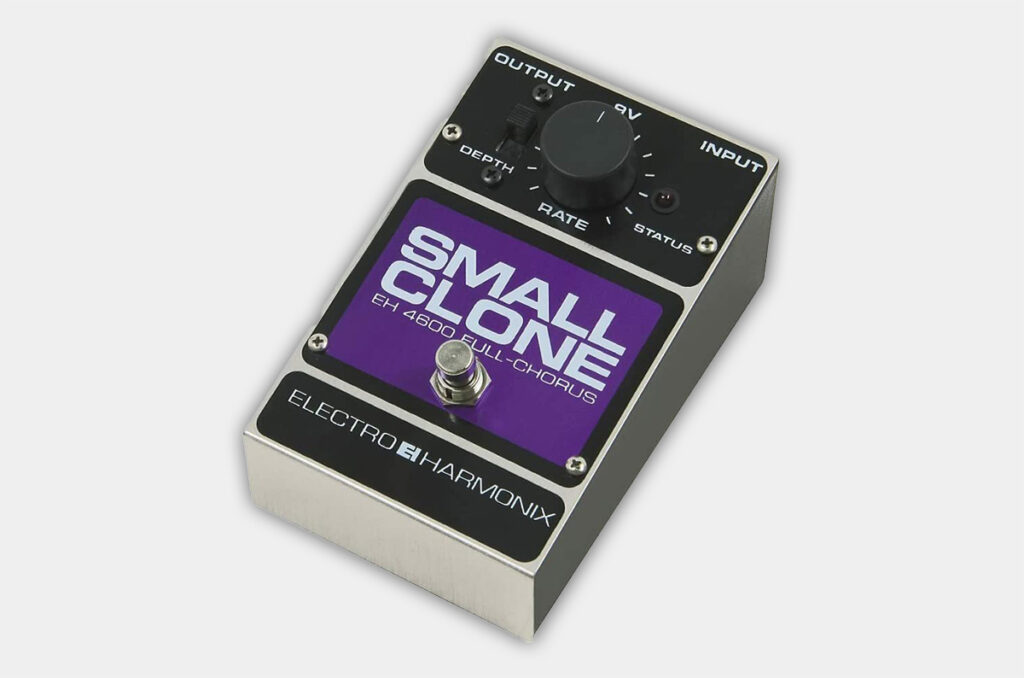
SPECIFICATIONS
Parameters: Rate, Depth
Inputs/Outputs: Mono input, mono output
Bypass: True Bypass
Analog/digital: Analog
LINK
ARGUMENTS IN FAVOR
- Legendary sound of Kurt Cobain/Nirvana
- Very easy to find the perfect sound
- Incredibly good price/performance ratio
NEGATIVE POINTS
- Not as flexible as other models
First up is what I consider to be the best chorus pedal of all time, the Electro Harmonix Small Clone. It is 100% analog (it creates the chorus effect by delaying the signal by a few milliseconds and mixing it back with the original signal) and relatively simple - it has only one knob and one switch.
The Rate control sets the modulation speed of the chorus. The Depth control determines how much the effect modulates. This allows you to create many different sounds!
This chorus pedal became especially popular because Kurt Kobain used it. The intro to Nirvana's world famous song "Come As You Are" was played with this pedal. If you set the Rate control to about 11:00 and the Depth switch to the upper position (i.e. maximum), you will get exactly this sound.
Otherwise, this chorus pedal sounds wonderful. At low to medium rates, the guitar still sounds relatively natural and harmonious, but as you turn the rate up, the sound becomes rather alien because the chorus modulates very quickly.
I have owned this pedal for 5 years and can truly say that it leaves nothing to be desired. Whether it is used on an electric guitar or as a mixing effect, the pedal has never disappointed me - it always delivers a great sound. In my opinion, it sounds much better than any plug-in! And for such a great effect, I think the price of 95€ is almost ridiculous.
Boss CE-2w
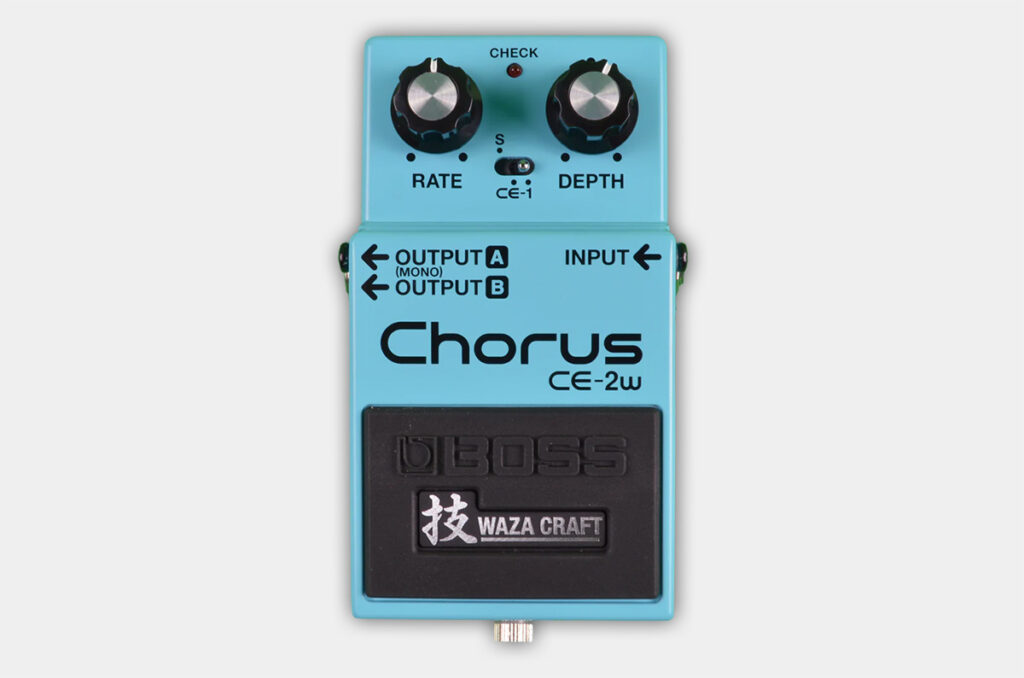
SPECIFICATIONS
Parameters: Rate, Depth, Mode selection
Inputs/Outputs: Mono input, stereo output
Bypass: Buffered
Analog/digital: Analog
LINK
Boss CE-2w (248€)
ARGUMENTS IN FAVOR
- Very versatile, as two chorus modes and a vibrato mode are available
- The same sound as the legendary Roland JC-120
NEGATIVE POINTS
- Comparatively expensive
The Boss CE-2 was the successor to the very first chorus pedal, the Boss CE-1, and the CE-2w combines these two legendary pedals in a single unit. So you get the legendary chorus of the Roland Jazz Chorus 120 that you heard on so many recordings in the 80s, along with the vibrato effect of that amp. Plus the modern sound of the Boss CE-2!
The center switch selects the three different modes of the CE-2w: Standard (the sound of the CE-2), CE-1 Chorus (the chorus effect of the CE-1/JC-120), or CE-1 Vibrato (the vibrato effect of the CE-1 (JC-120)). All three of these effects sound great: The chorus and vibrato effects of the CE-1 both sound rather "vintage" and like the well-known Roland Jazz Chorus 120, but with better and clearer highs. The CE-2 sounds a bit more modern and moderate than the CE-1.
Otherwise, this pedal has only two controls, Rate and Depth. However, this allows you to create a lot of sounds in each of the three modes. From Metallica to U2 to the Red Hot Chili Peppers, this pedal allows you to perfectly imitate the sound of various musical eras.
This chorus pedal also works 100% analog with bucket brigade components, similar to analog delays. After all, an analog chorus is a delay, but with very short delay times. This naturally results in a warmer, vintage sound compared to digital chorus effects.
The price is relatively high for a chorus pedal, but this little beast also includes 2 different pedals and a total of 3 modes, so the price is reasonable.
MXR M 234 Analog Chorus
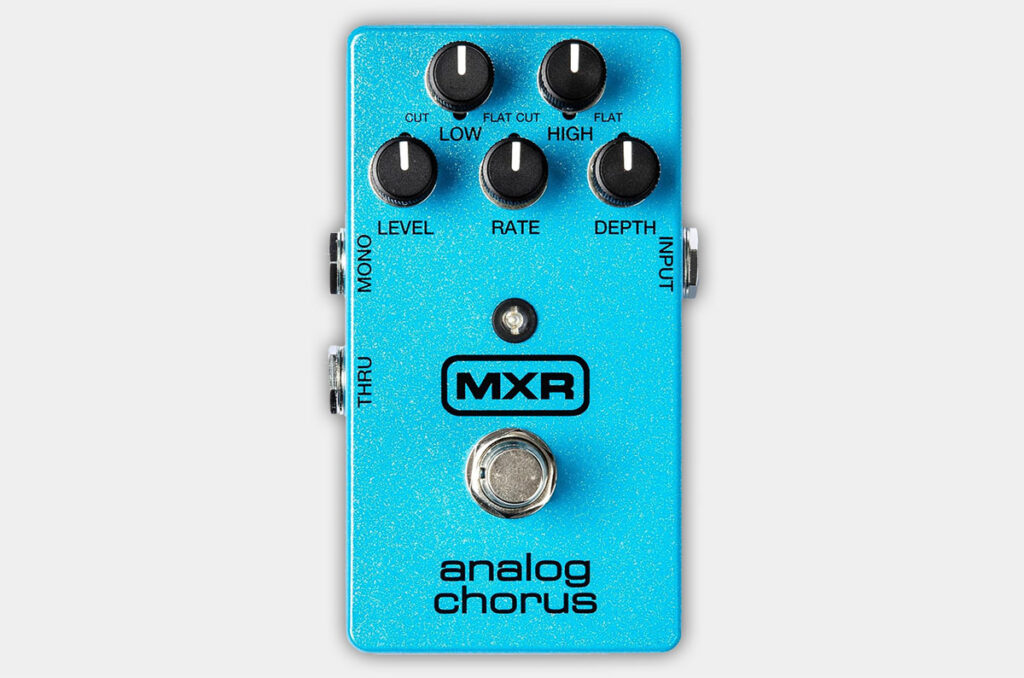
SPECIFICATIONS
Parameters: Level, Rate, Depth, Low, High
Inputs/Outputs: Mono input, stereo output
Bypass: True Bypass
Analog/digital: Analog
LINK
MXR M 234 (139€)
ARGUMENTS IN FAVOR
- Many different sounds are possible due to the many parameters
- Affordable
- Beautiful, warm sound
NEGATIVE POINTS
- –
The MXR M 234 is another classic analog chorus pedal based on the bucket brigade circuit. This pedal is very compact, but still offers a wide range of sound shaping options.
In addition to the usual controls for Level, Rate and Depth, the MXR M 234 offers a 2-band EQ with controls for treble and bass. This allows you to create many different chorus sounds, from dark to bright.
For example, this pedal can perfectly imitate the two different chorus modes of the Boss CE-2w if you adjust the EQ accordingly. The "Level" control is also very handy and can be used to perfectly adjust the ratio between the chorus and the original signal.
This pedal can be used mono (with one guitar amp) or stereo (with two guitar amps, ideally the same amps), and in stereo mode the signal gets really fat and wide. You don't want to use it all the time, but it can work wonders for soundscapes or more experimental sounds in general.
This chorus pedal is lightweight and small enough to fit on any pedalboard. It can be powered by an AC adapter or a 9V battery and costs only €139.
tc electronic JUNE-60 Chorus V2
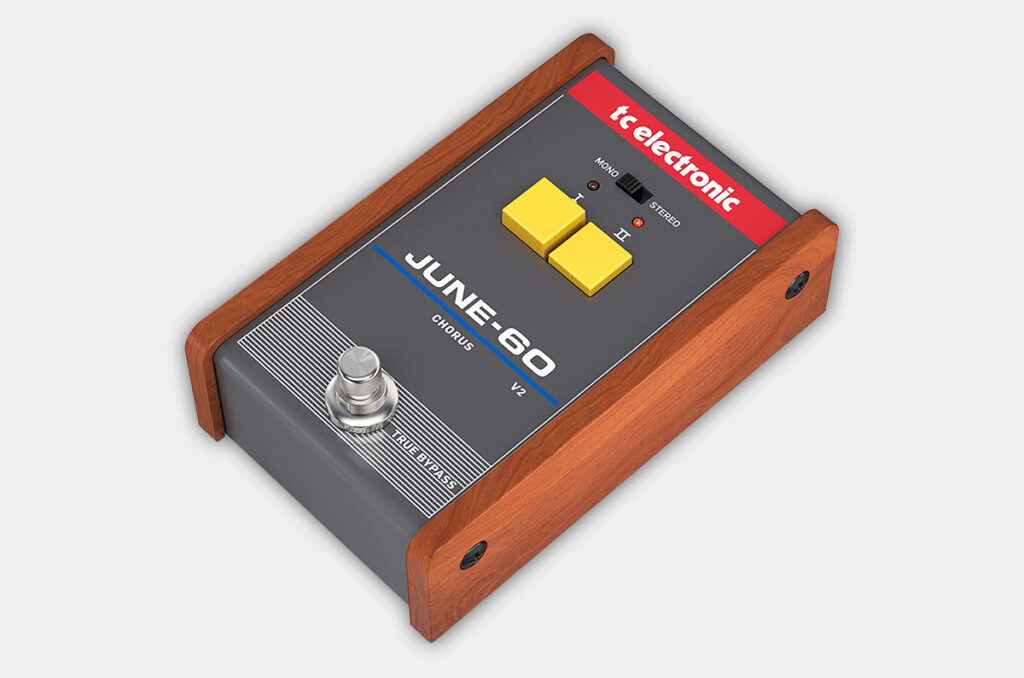
SPECIFICATIONS
Parameters: Preset selection (3 presets), Mono/Stereo switch, Rate SLOW/FAST (via rear panel DIP switch)
Inputs/Outputs: Mono input, stereo output
Bypass: True Bypass
Analog/digital: Analog
LINK
ARGUMENTS IN FAVOR
- Legendary chorus sound from one of the most sought-after synthesizers of all time
- Very cheap
NEGATIVE POINTS
- Very few setting options
This pedal is a modern clone of a very famous chorus effect, namely the built-in chorus of the legendary Roland Juno-60. This synthesizer was released in 1982 and enjoys enormous popularity today, which has driven up prices (on the second-hand market they now cost between 2,000 and 6,000 Euros).
The effect is quite simple and doesn't offer many settings, but the sound is incredibly beautiful. It works great on electric guitars or synthesizers and can also be used as a mixing effect. In my opinion it sounds best with synthesizers. It also works 100% analog with bucket brigade components.
It can be operated in both mono and stereo (via a single TRS output, similar to the insert point on a mixing console), and in stereo it produces a very nice, wide sound that is perfect for sound surfaces or ambience.
However, compared to the other models on this list, this pedal is a bit more limited in terms of control - there are no Rate or Depth controls, at least none that can be selected directly. You can change these parameters via internal DIP switches (you can choose between SLOW and FAST), but you have to open the pedal to do so. So it's not very convenient.
Nevertheless, this chorus pedal has a very good price-performance ratio, as it costs only €62 and the sound is really good.
Boss DC-2w
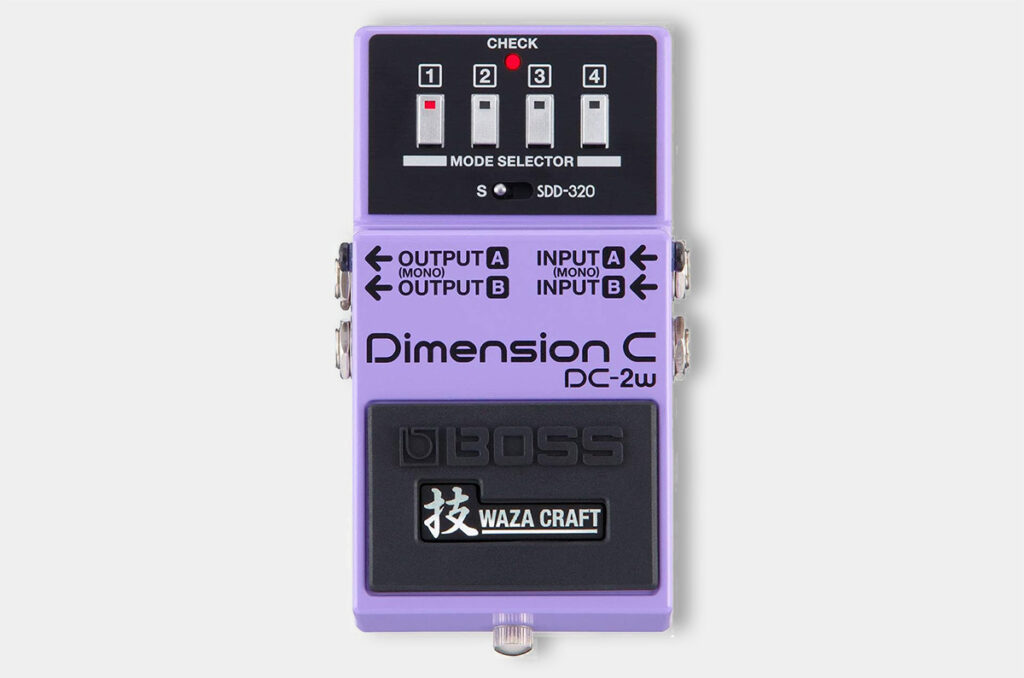
SPECIFICATIONS
Parameters: 4 Mode selector, S/SDD-320 switch
Inputs/Outputs: Stereo input, stereo output
Bypass: Buffered
Analog/digital: Analog
LINK
Boss DC-2w Dimension C (249€)
ARGUMENTS IN FAVOR
- Legendary chorus sound
- Chorus sounds incredibly beautiful, no other chorus pedal produces such a sound
- The result is a very nice stereo image
NEGATIVE POINTS
- Not cheap
The Boss DC-2w is a reissue of the legendary Boss Dimension C, one of the most popular chorus pedals of the 80s. This pedal is unique in that it is the only chorus pedal that uses two parallel bucket brigade circuits to create a stereo signal. This produces a very wide signal in stereo mode.
Not only does it offer sounds from the Boss Dimension C, but also from the legendary Roland SSD-320 (also known as the Roland Dimension D), one of the most popular chorus effects in the studio. This effect can still be found in most professional recording studios today and has been used on many productions over the last 40 years.
The Boss DC-2W is an incredibly powerful effect unit that combines two legendary effects in a small package. Although there are no controls, only "presets", they sound so incredibly good that they are completely sufficient for professional mixing applications.
A switch allows you to choose between the standard mode (Dimension C) and the SDD-320 mode, and the 4 buttons allow you to select the 4 presets for each mode.
The pedal is a bit more expensive than the other models on this list, but still significantly cheaper than an original Roland SSD-320. If you only want to use it as an electric guitar effect, there are other models that do the job just as well and cost half as much.
But if you want to use it for mixing or for synthesizers, then I can recommend it to everyone, because the sound is really unique. It's not for nothing that the Roland SSD-320 can be found in every studio and now costs over €1,000 (used!).
Walrus Audio Julia V2
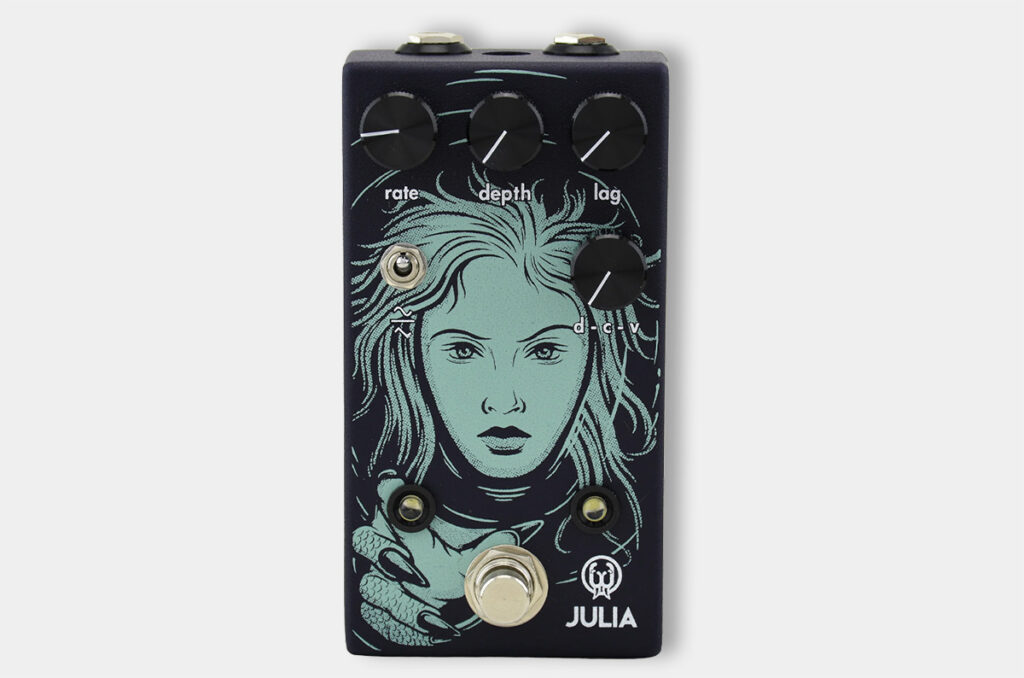
SPECIFICATIONS
Parameters: Rate, Depth, Lag, Waveform switch, d-c-v
Inputs/Outputs: Mono input, mono output
Bypass: True Bypass
Analog/digital: Analog
LINK
Walrus Audio Julia V2 (219€)
ARGUMENTS IN FAVOR
- Many possibilities for sound design
- Also includes the vibrato effect, both effects can be combined
NEGATIVE POINTS
- No stereo capability
The Walrus Audio Julia V2 is also a very special pedal with many functions. It contains a chorus and a vibrato effect that can be applied to the signal individually or together. This ratio can be adjusted with the d-c-v (dry chorus vibrato) - the combination of chorus and vibrato can produce very interesting sounds.
This chorus pedal is 100% analog, and in addition to the Rate and Depth controls, it also has a Lag control that lets you adjust the delay time of the LFO. This adds even more movement (modulation) to the sound, which can range from very smooth to very detuned.
Another switch lets you select the waveform of the LFO (sine or triangle). This opens up even more sonic possibilities. With all these features, this chorus pedal allows you to create really crazy sounds that sound anything but natural! But even mellow sounds are no problem if you turn down the depth control.
Recommended for guitarists who want to keep all sonic doors open.
TC Electronic Corona Chorus
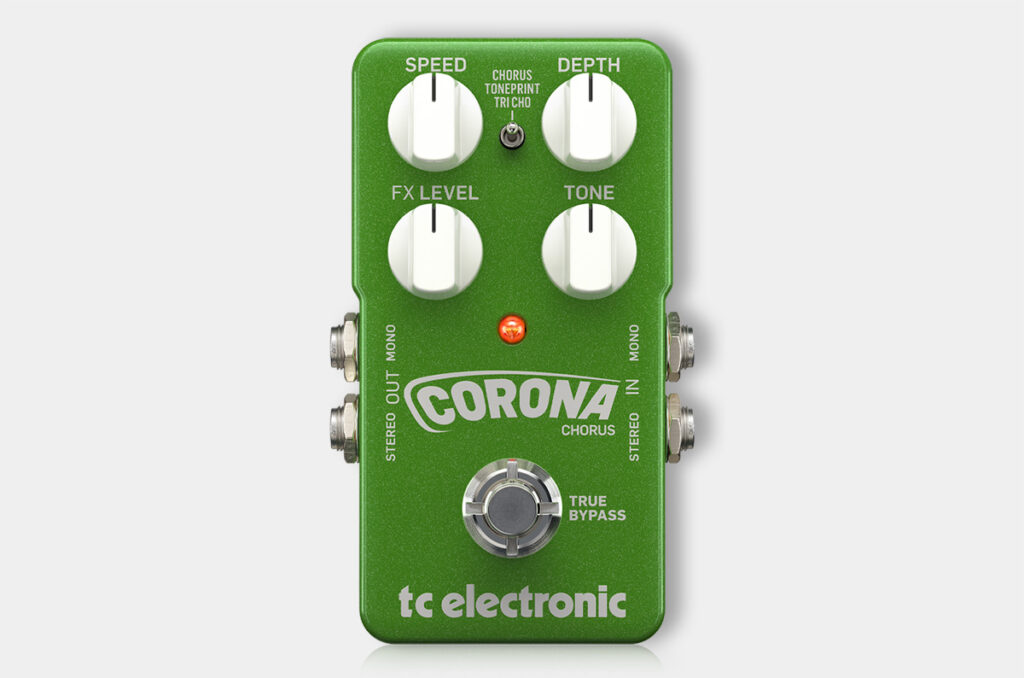
SPECIFICATIONS
Parameters: Speed, Depth, FX Level, Tone, Mode Selector
Inputs/Outputs: Stereo input, stereo output
Bypass: True Bypass and Buffered Bypass (can be selected)
Analog/digital: Digital
LINK
TC Electronic Corona Chorus (119€)
ARGUMENTS IN FAVOR
- Toneprint allows a virtually infinite number of sounds
- Many sound design parameters
- True Bypass AND Buffered Bypass selectable
NEGATIVE POINTS
- –
The TC Electronic Corona Chorus is a very powerful digital chorus pedal, the first digital one in this list. But that doesn't mean it sounds worse than the others - even if the sound isn't quite as warm or "vintage", this pedal has the great advantage of flexibility.
Because this pedal has the great TonePrint functionality, which allows you to save external presets in the pedal via your smartphone. This gives you virtually unlimited tonal possibilities! The TonePrint app offers hundreds of presets that you can easily import into the pedal. You can also create your own presets, which have many more parameters than the pedal itself.
The pedal itself offers 4 controls (Speed, Depth, Tone and FX Level) which is quite impressive. There is also a switch that lets you choose between the pedal's 2 chorus modes or the TonePrint mode. So even without the TonePrint functionality, this pedal offers an enormous variety of sounds - but the TonePrint functionality comes on top and is marvelous!
The Corona Chorus works in both mono and stereo, so it has two inputs and two outputs. Another great feature is that you can choose between true bypass and buffered bypass - buffered bypass is better if you are using long cables, because without buffered bypass the high frequencies will be lost a bit.
With a retail price of €119, this digital chorus pedal is relatively inexpensive. Especially when you consider all the things you can do with it!
Boss CH-1 Chorus
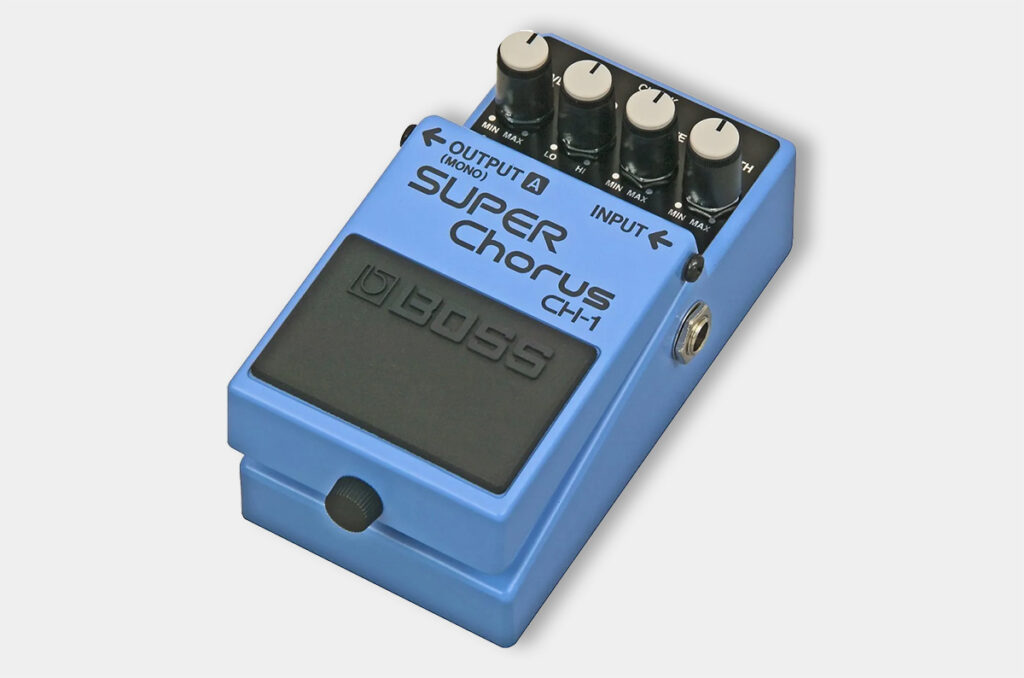
SPECIFICATIONS
Parameters: Effect Level, EQ, Rate, Depth
Inputs/Outputs: Mono input, stereo output
Bypass: Buffered bypass
Analog/digital: Digital
LINK
Boss CH-1 Chorus (115€)
ARGUMENTS IN FAVOR
- Crystal clear heights
- EQ is very practical
NEGATIVE POINTS
- Sound can be a little intrusive (depending on the situation)
Another chorus pedal from Boss, but this time digital. The Boss CH-1 is very popular with guitarists because it offers so many possibilities. Especially the built-in EQ can work wonders and make the sound really bright and brilliant. Perfect for clean guitar sounds!
The pedal offers the usual knobs: Speed, Depth, Effect Level and the already mentioned EQ. The EQ works with a single knob - turning it to the left boosts the low frequencies and cuts the high frequencies, and turning it to the right does the opposite.
The pedal has a mono input but a stereo output, and the pedal really comes into its own in stereo mode. It creates a depth/dimension that you could never achieve without a chorus effect. Perfect for epic guitar tones! Keep in mind that you need two amps of the same model for true stereo operation.
Compared to other chorus pedals, the sound is brighter and a little more overpowering - but you can use the EQ to take away some of the highs if you want. Like all Boss pedals, it is extremely rugged and will serve you well forever.
How does a chorus effect work?
A chorus effect simulates the sound created when several identical instruments (or voices) are played at the same time, but in slightly different ways. Important: Such a sound is not created by simply doubling an audio signal - then the signal would sound the same, but louder.
To create this wide, chorus-like sound, the copied signal must be slightly different to create this "dimension". This is similar to doubling vocals in recordings to make them sound thicker.
Specifically, a chorus effect works like this:
- Duplicating the signal: First, the incoming audio is duplicated. The original remains unchanged while the duplicate is processed.
- Modulation: The duplicated signal is then modulated with a low frequency oscillator (LFO). This means that the pitch and/or delay of the signal is changed slightly and continuously. These changes are usually very small, typically in the range of a few milliseconds for delay and less than a semitone for pitch. Chorus is most often created with time delay.
- Mixing: The modulated signal is thus delayed slightly and then mixed back with the original signal. The delay time is often so short that it is not perceived as an echo, but rather as a thickening effect.
- Generation of the chorus effect: The continuous modulation creates an effect that sounds like multiple instruments are playing at the same time. The slight differences in pitch and/or time between the original signal and the modulated signal create a richness and movement that adds depth and character to the sound.
- Further sound adjustments: By adjusting parameters such as Rate (modulation speed), Depth (modulation depth), and Mix (ratio between the original signal and the effect signal), you can customize the sound of the Chorus effect.
What are the parameters of the chorus pedals?
Every pedal is different - some offer more parameters to adjust than others, but some parameters are the same for all pedals:
Rate (speed): This parameter controls the modulation rate of the Chorus effect. A higher rate produces faster oscillations, resulting in a more intense, dramatic effect. A lower rate produces a more subtle, softer chorus effect.
Depth: Depth determines how much the modulated portion of the signal varies. Greater depth means more modulation, resulting in a stronger, clearer chorus effect. A lower depth produces a more subdued, subtle effect.
Level or Mix: This control determines the relationship between the unmodulated original signal and the modulated chorus effect. Depending on the pedal, the effect can be completely isolated or subtly added to the original signal.
Tone (tone colour): Not available on all chorus pedals, but if it is, this parameter can be used to adjust the tone of the effect. By adjusting the Tone control, you can add more treble for a brighter effect, or reduce the treble for a warmer, mellower sound.
Feedback (feedback): On some chorus pedals, this controls the amount of the modulated signal that is fed back into the effect input. Higher feedback settings produce a more intense and often more extravagant chorus effect because the signal is modulated multiple times.
Analog vs digital chorus
Analog chorus pedals use analog circuitry, typically bucket brigade devices (BBDs), to delay and modulate the signal. BBDs are a series of capacitor-based storage cells that pass the audio signal from one cell to the next with a delay in a kind of "relay race. Analog chorus pedals are essentially analog delay pedals, but with very short delay times and the ability to modulate that delay time.
The sound of an analog chorus pedal is often described as warmer and more natural. The nature of analog processing often results in a slight imperfection in the signal, such as a slight hiss, which many musicians consider part of the charm and character of analog sound.
Digital chorus effects use digital signal processors (DSPs) to modulate the audio signal. The analog signal is first converted to a digital signal, modulated, and then converted back to an analog signal. Digital chorus pedals therefore have built-in AD/DA converters.
As a result, they sound cleaner and more precise. They are capable of very complex and precise modulation, resulting in a wider range of sonic possibilities. They are more flexible, often offering multiple parameters for sound shaping and often different chorus modes.
Related articles:





